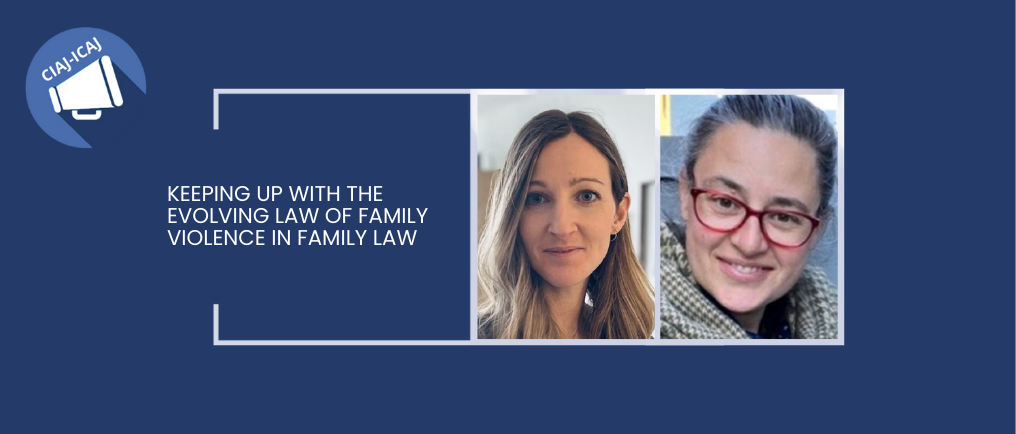Keeping up with the Evolving Law of Family Violence in Family Law

The past three years have seen the introduction and implementation of significant family law reforms to the ″Divorce Act″, and a number of provincial acts, with many amendments focused on family violence. Since then, case law has continued to evolve across the country, providing interpretations on what constitutes family violence and highlighting the importance of understanding family violence for fully evaluating the best interests of the child.
Considering these recent changes, we thought we would provide some tools and resources that may be helpful for legal professionals looking to stay up to date on this complex and changing area of the law.
Analyzing a Family Violence Claim
The introduction of a new definition of family violence in the Divorce Act and the inclusion of family violence as a best interests consideration has necessitated a focus on how family violence is to be considered when determining the best interests of the child. One case we continue to refer back to is MAB v. MGC, 2022 ONSC 7207 at para 177, where Chappel J. provides a useful general roadmap* for analyzing family violence claims including determining whether conduct amounts to family violence, the direct or indirect impact it may have on children and the appropriate parenting arrangement.
Screening and Safety Planning for Clients
Asking clients about family violence is an important part of a family law lawyer’s role. However, knowing how to do so in a meaningful and trauma-informed way can be difficult. Here are a few resources that may help with a framework for navigating these discussions and building safety plans that help keep clients (and lawyers) safe.
- The HELP Toolkit is an important tool for lawyers to have discussions with clients about family violence throughout a file and how to explore immediate risks and safety concerns, including tips for promoting safety.
- Luke’s Place created a report, What You Don’t Know Can Hurt You: The importance of family violence screening tools for family law practitioners providing 10 recommendations along with a screening template for lawyers.
- The Barbra Schlifer Commemorative Clinic recently developed the RISA Tool for frontline service providers working with survivors of GBV. It is intended to assist service providers in screening and identifying potential risk for future violence and assist with safety plans and case management, with considerations of intersectional factors.
Keep up to date: Case Law and Social Science
Lastly, staying up to date can be a challenge, so we’ve highlighted some free resources and newsletters where lawyers can subscribe to get the latest updates:
- JustInfo Newsletter: This is our regular newsletter, which provides family law case summaries on family violence, news, new resources, events and more.
- Luke’s Place News: See the Luke’s Place blog for case summaries, resources, new trainings and commentary on current events.
- Family Violence Family Law: Access legal bulletins, briefs and webinars highlighting issues at the intersection of family violence and family law.
- Centre for Research & Education on Violence Against Women & Children (CREVAWC): Featuring research, resources, events and trainings/certificates addressing gender-based violence.
- Lam Family Law Newsletter: This bi-monthly newsletter provides updates on family law and practice, including case law commentary, online resources and tips for researching and drafting.
- Bottom Line Research – Complimentary Clippings: Receive regular family law case summaries to your inbox.
*See Chappel J.’s roadmap from MAB v. MGC, 2022 ONSC 7207 at para 177 reproduced in part here:
1. Assess the credibility of the allegations.
2.Determine whether the conduct constitutes ‘‘family violence” within the meaning of the legislation …
a. Was it conduct by one ‘‘family member” toward another ‘‘family member? …
b. Does the conduct fall within the examples of family violence listed in [the Act]?
c. If the conduct does not fall within the examples listed in [the Act], does it nonetheless qualify as ‘‘family violence” … on the basis that it is:
i. Violent or threatening; or
ii. It constitutes a pattern of coercive controlling behaviour; or
iii. It causes the other family member to fear for their own safety or that of another person?
d. If it is alleged that the child has experienced family violence, determine not only whether the child has been the direct victim, but also whether they have been directly or indirectly exposed to family violence.
3. If the behaviour amounts to family violence … determine the impact of the family violence on the following:
a. The ability and willingness of the person who engaged in the violence to care for and meet needs of child;
b. The appropriateness of making an order that would require cooperation on issues affecting the child; and
c. On any other relevant consideration.
4. In determining the impact of family violence, take into account all relevant considerations, but make sure to specifically consider and weigh the factors listed [in the Act]. …

